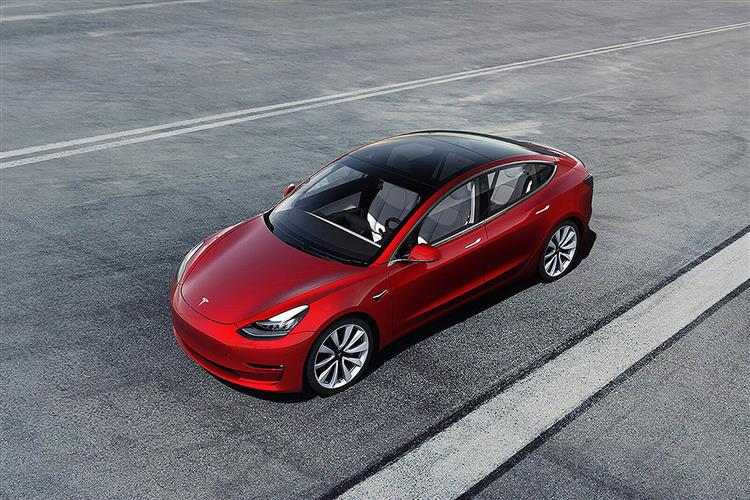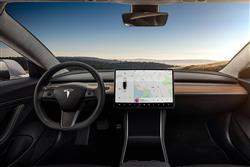How will you view?
This is a sample, showing 30 seconds of each section.
TES OF THE URBAN HILLS (some text hidden) SECTIONED_new_teslamodel3_2019
By Jonathan Crouch
Introductionword count: 58
Launched in the UK in 2019, the Model 3 was Tesla's more significant car to date, mainly because it was the company's most affordable product. It's all-electric of course and in Dual Motor form offered industry-leading EV driving range. It was also the company's first four-door design. Here we look at the pre-facelift 2019-2023 versions of this car.
Modelsword count: 10
5dr Saloon (EV) [Standard Plus, Rear-Wheel Drive, Dual Motor, Performance]
Historyword count: 311
From its establishment back in 2003, Tesla's goal was always to make cars that would provide a credible alternative to mass market combustion-engined models. The company's initial contenders, the Model S and the Model X, showed what was possible in the pricey luxury market. But it's this Model 3 that brought the Elon Musk global vision within reach of the man in the street. The reasonably well-heeled man in the street anyway: prices placed this saloon plumb into the kind of BMW 3 Series / Mercedes C-Class territory that from launch in 2019 it was sized to address. Buyers in this segment hadn't previously been offered a credible EV; cars with full-battery power had previously tended to be based either on compact family hatches or big luxury SUVs. But that was because in the past, a customer of a volume segment executive model couldn't have tolerated the kind of relatively feeble real world operating range that until the Model 3 arrived had characterised most all-electric models. Tesla addressed that here - with the Dual-Motor variants at least - and gave owners much greater access than they'd have had with other brands to the super-powerful public charging points needed for quick battery replenishment. But the Model 3 was much more than just a showcase for electrified technology. In creating it, this American maker battled with bankruptcy, struggled with quality control issues and fought against production bottlenecks at a Californian plant in Freemont that until the Tesla era was resolutely low-tech. Any one of these issues could have killed the company. Instead, it delivered on its vision of affordable executive EV motoring and produced a US market best seller that some think is the most important vehicle of the last decade. Here, we look at the earlier 2019-2023 versions of this model which sold until a far-reaching 'Project Highland' update in late 2023.
What You Getword count: 590
It's a mark of Tesla's brand identity that even someone unacquainted with EVs would probably recognise this car's maker. They might perhaps be less likely to recognise it as a Model 3, though on closer inspection, the cues are quite distinct, though still very much EV-orientated. Starting at the front, where this more affordable Tesla design sees no need for the decorative front grille that aimed to ease the Tesla transition for Model S and Model X customers graduating over from something more conventional. A little overtaking presence has been lost as a result. From the side, you notice the short bonnet, facilitated by the 'skateboard'-style chassis that locates the drivetrain and the batteries as low as possible in the car, enhancing interior space and lowering the centre of gravity. From almost any angle, this car looks more like a hatch than a saloon - including from the rear. It's certainly very Model S-like. As with that car, Tesla's mounted the charging flap neatly in the offside rear light cluster - and made the socket inside CCS-compatible so that a wider number of public charging stations can be used. Once inside, you find yourself seated in a cabin that's more minimalist than a Scandinavian loft. Well, in terms of button clutter anyway. There's nothing minimalist about the enormous 15-inch central touchscreen, on to which virtually all the driving, comfort and infotainment features you'll need have been located. Beyond this, operating control provision has been kept to the absolute minimum. Which is all well and good, but a potential premium segment European buyer of this car is ideally going to want such minimality to be accompanied by the kind of cabin quality and richness of interior design that the posh German brands offer. You don't really get that here, but compensatory technology is absolutely dripping from every menu and pinch-and-swipe action accessible through this enormously capable central screen. There's a superb Google Earth navigation system, all the usual infotainment stuff and even arcade games. The driving position sits you a little higher than the segment norm and the lack of central transmission tunnel frees up load of space for useful extra stowage compartments. At first glance, all seems good on the back seat, especially compared to the cramped rear quarters you'd get in a rival BMW 3 Series or Mercedes C-Class. Take a seat though and you find a raised floor matched with low-set seats, the result being that you sit with your knees slightly higher than they would normally be. Once you adjust to this, you'll find that legroom isn't bad - one six-footer can just about sit behind another thanks in part to the scalloped seat backs - though the fact that you can't slide your feet under the seat in front is something of a limiting factor. And the boot? Well the capacity on offer here - 425-litres - is 55-litres less than you'd get from a BMW 3 Series or Audi A4 but only fractionally less than a Mercedes C-Class. Anyway, it's a good, square, usable space, with a recessed area to the left and a deep well under the cargo base for the charging leads that could also take other small items you might not want sliding around the boot floor. We'll finish by considering the 'frunk', the 'froot' or whatever you want to call it up-front in the nose. It can't quite swallow suitcases like the one in the Model S, but its 117-litre capacity is probably good for a couple of small squashy bags.
To see the full road test text contact us on 0330 0020 227
Pictures (high res disabled)

.jpg)
|
.jpg)
|
.jpg)
| |||
.jpg)
|
.jpg)
|
.jpg)
| |||

|
Scoring (subset of scores)
Category: Hybrid, Plug-in, Electric & Hydrogen
| Performance | |
| Handling | |
| Comfort | |
| Space | |
| Styling, Build, Value, Equipment, Depreciation, Handling, Insurance and Total scores are available with our full data feed. | |



